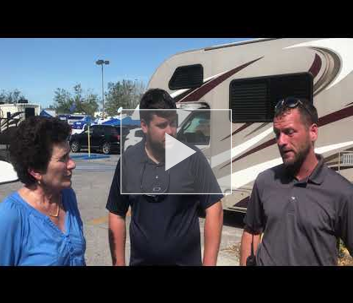Hurricane Michael’s Florida Devastation & Recovery
Good Monday morning. Today is the 12th day after Hurricane Michael hit Florida’s panhandle as a strong Cat 4 storm with sustained winds of 155 mph. So far, 25 people have died in the storm or its aftermath, the latest this past Thursday, when a tree fell on a Gulf County firefighter who was clearing debris with his family. Another 10 people have died in Georgia, North Carolina, and Virginia. Names of some of the dead remain unknown. The search for missing relatives continues this week for nearly 200 families, as search and rescue missions continue. As of last night, 1,624 people were still living in 10 remaining shelters.
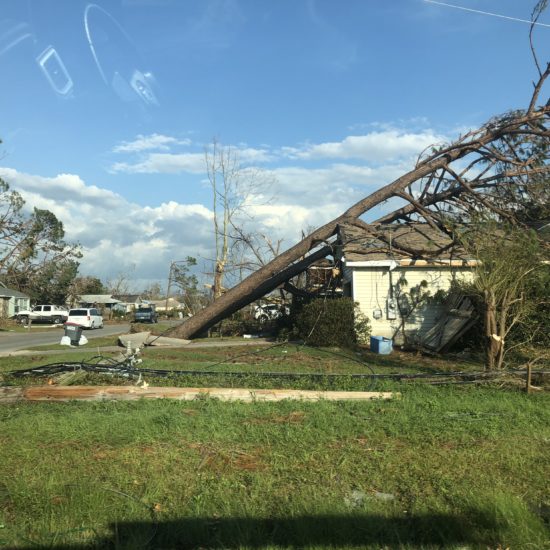
Fallen trees on roofs are a common sight in Florida’s panhandle
While there was some flash flooding, Michael was an old school hurricane – big wind and big (9 foot+) coastal storm surge. Big trees fell, homes were ripped apart, and as of last night 82,000 people are still without electricity in the greater nine county area of the panhandle (compared to 388,000 after the storm hit).
The stories and pictures we are sharing in this newsletter show some of the damage that earned Michael its fourth place spot among the strongest hurricanes to hit the U.S. I saw this devastation first hand when I was in Panama City last week at the insurance village, working with some of the 44 assembled insurance companies and others in the recovery that has become a new full-time vocation for many. With temperatures back in the 90’s, everything was literally one hot mess, including cellular telephone service. Some law enforcement had just regained use of their radio dispatch systems. The picture above – of fallen trees on houses – best represents the most common type of damage.
According to their website under “DFS Insurance Villages” the Department of Financial Services is hosting a third insurance village today and tomorrow (October 22 & 23) in Marianna in the parking lot of the Lowe’s from 8am to 4pm, CST.
In the coming pages we’ll brief you on how Florida’s insurance companies are weathering the claims losses, what insurance regulators are doing, and the proactive fight being waged against fraud and the use of Assignment of Benefits (AOB) contracts in the homeowners repair process. I’ll share more of my personal observations and revelations from my travels through some of the worst hit areas of Marianna and Panama City and my report from the insurance village there.
Michael’s Damages and Insurance Claims
Florida’s domestic insurance companies good to pay
Beyond Hurricane Michael’s cost in human lives, is the cost of rebuilding homes, businesses, and infrastructure through insured losses. AIR Worldwide estimates the losses will be between $6 billion to $10 billion. The figure includes residential, commercial, and industrial properties and automobiles. It does not include National Flood Insurance Program losses. The 35 insurance companies that write a large portion of the market in the impacted areas are expected to cover the claims just fine through reinsurance, despite inflated claims due to outdated building codes.
AIR Worldwide expects damage from the Cat 4 storm – which was just 2 mph shy of a Cat 5 – will be even worse, given the number of older buildings built prior to more modern and resilient building codes. The majority of structures, according to an AIR analysis, were built prior to 1995 using the less stringent Standard Building Code, which was updated after 1992’s Hurricane Andrew in Homestead, Florida.

A photo of a damaged house in Port Saint Joe taken by a drone
Most Panhandle structures are designed to withstand 3-second gust values of between 120mph and 140mph, which was well below Michael’s sustained wind speeds of 155mph and 3-second gust values of between 160mph and 175mph. “Given that portions of the Panhandle were subjected to wind speeds in excess of this design level during Hurricane Michael, significant damage is expected to the building stock there,” according to AIR engineers.
Several of my fellow insurance colleagues on the ground with me in Panama City noted that remarkably, the standing seam metal roofs stood up great, with no damage. Gable and three cap shingles were often completely gone (see pictures). The picture of the green metal roof was taken by a drone, evidence of the growing use of technology in the CAT adjustment and claims process. Thank you to Jason Brugh, a New Port Richey adjuster, for sharing these photographs.
Rains and thus flooding weren’t much of a factor with Michael, given the fast moving nature of the storm and rainfall of only 4-8 inches – only local flash flooding was reported in spots.

Damage to homes in Mexico Beach, FL from Hurricane Michael
While most of the building stock is older and thus more severely damaged than it might be otherwise, on the plus side for insurance interests is that Florida’s panhandle is pretty sparsely populated. Mexico Beach, at ground zero for Michael, had but about 2,000 residents. Outside of Panama City (population 38,000), most of the 9-county region impacted is rural.
Industry analysts thus expect Florida insurance companies should be able to cover all claims. Reinsurance programs performed well after Hurricane Irma last year, which caused about $50 billion in damages in Florida and are expected to do well again with Hurricane Michael.
Demotech doesn’t expect any of its 52 Florida-based companies to push through the top of their reinsurance. “Carriers reviewed and rated by Demotech purchased, in the aggregate, more than $28 billion of first event catastrophe coverage,” said VP and co-founder Sharon Romano. “Despite the devastation, as of this date, we believe that every carrier that Demotech reviews has the capital and the reinsurance necessary to respond to Hurricane Michael.” Demotech President and co-founder Joe Petrelli always says, that if there is one thing that Florida’s domestic carriers know better than anyone, it’s the value of a rigorous reinsurance program to protect and serve policyholders.
Advisers to the Florida Hurricane Catastrophe Fund projected in a report earlier this month that the fund balance would total $13 billion as of Dec. 31, assuming no landfall-making storms. S&P said it expects insurance companies and reinsurers will be able to pay claims through premiums collected and other earnings, without touching their capital.
Florida Regulatory and Legislative Response to Michael
Suspension of key practices in place post-storm
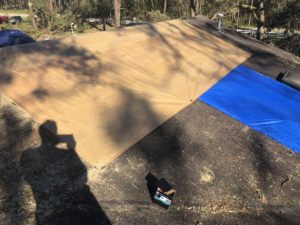
A catastrophe adjuster takes pictures of a damaged roof on a Bay County, FL home after Hurricane Michael
A freeze on property insurance rate increases, a moratorium on policy cancellations, and a data call are some of the responses to Hurricane Michael by Florida insurance regulators. In a conference call with carriers prior to the storm’s October 10 landfall, regulators emphasized the importance of post-storm claims reporting, the availability of insurance adjusters, and homeowners’ abilities to file claims when traditional communication lines are down.
Regulators made it clear they expected insurance companies to be prepared and have an appropriate number of adjusters on staff to meet consumers’ post-storm needs. And they have, so far, by all reports. We know that claims filing is slow, as residents have struggled with communications services. Adjusters have been getting out there as fast as they can. There are more than 232,600 licensed individuals who are available to adjust hurricane damage claims in Florida, according to the state Department of Financial Services. We’re going to meet a couple of special ones later in this newsletter.
The Florida Office of Insurance Regulation (OIR) issued an emergency order, which among other provisions, provides an additional 90 days to policyholders to supply information to their insurance company; prohibits insurance companies from canceling or non-renewing policies covering residential properties damaged by the hurricane for at least 90 days; and freezes any and all efforts to increase rates on policyholders for 90 days, effective October 15.
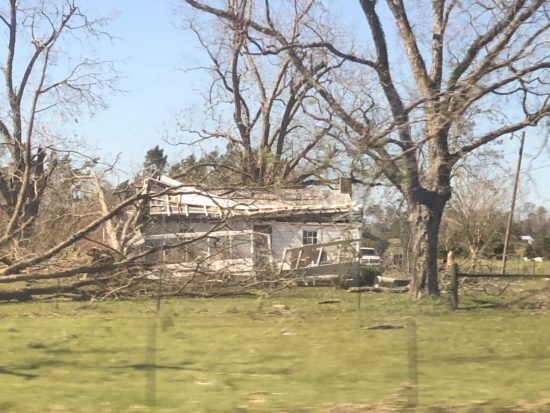
A rural home damaged by Hurricane Michael
Both Florida OIR and the Georgia Office of Insurance and Safety Fire Commissioner have issued data calls for Hurricane Michael claims to P&C insurers. Michael entered Georgia as a Cat 3 hurricane but has done little structural damage. In Florida, nearly 80,000 claims totaling an estimated $836 million in insured losses have been filed as of last Wednesday, the latest figures from OIR. Daily data calls are scheduled to continue through this Friday.
Legislative leaders say they are poised to provide additional monies as necessary toward long-term recovery. Exactly what those long-term needs are is still unclear. The state has almost $4 billion in reserves that could be used to address immediate needs of communities impacted by the hurricane, including repair of vital infrastructure.
Incoming House Speaker Jose Oliva (R-Hialeah) said in published reports that he wants to see what measures implemented after last year’s Hurricane Irma by the House Select Committee on Hurricane Response and Preparedness proved effective in Michael and which didn’t. “It is my hope that many of those recommendations became a reality, but we will likely assess what went wrong and what went right after we all work to help our fellow Floridians put their lives back together,” Oliva was quoted.
To be sure, parts of the Florida panhandle are bad and going to remain so for weeks into months. It could take several more weeks for power to be fully restored, let alone the rebuilding in hard-hit rural areas. In Calhoun and Jackson Counties, which lie north of Panama City and Bay County, extending to the Georgia state line, estimates are that 50-75% of homes have sustained significant damage – so bad, that some would not be safe to restore power. More than 63,000 people live in those two counties alone.
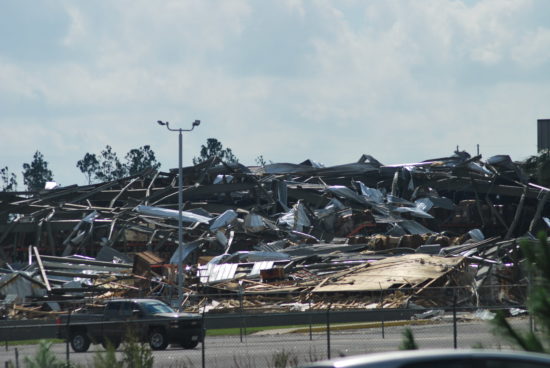
Business Damage at Bay Industrial Park near Panama City, FL
Likewise, there is concern some businesses may not recover from the hurricane, especially those that didn’t have insurance or business interruption insurance. The real job starts once the power is restored. In the meantime, people are out of work, especially in the service industry. The Small Business Administration is providing assistance through loans for the total loss up to it loan limits. The borrower agrees to use insurance proceeds to reduce or repay the loan. Florida has activated its small business Bridge Loan Program that provides short-term, interest-free loans that provide interim funding to reopen and stay open.
Florida has been awarded federal National Dislocated Worker Grants to provide temporary employment to Floridians affected by Hurricane Michael. This program is administered by the Florida Department of Economic Opportunity (DEO) and provides disaster relief employment in the form of temporary jobs that support storm response and recovery efforts.
The panhandle is a big timber producer. All those fallen trees have taken down the timber industry with them, with an estimated $1.3 billion in damages to the area’s pulp mills, sawmills, and other production facilities in 11 of the top timber-producing counties in the state, according to Agriculture Commissioner Adam Putnam.
Because of Hurricane Michael, the Office of Insurance Regulation Summit scheduled for this week has been postponed to a later underdetermined date and the NCCI Workers’ Comp Rate Hearing has been cancelled altogether.
View from the Street
A journey through post-Michael Panama City and the panhandle
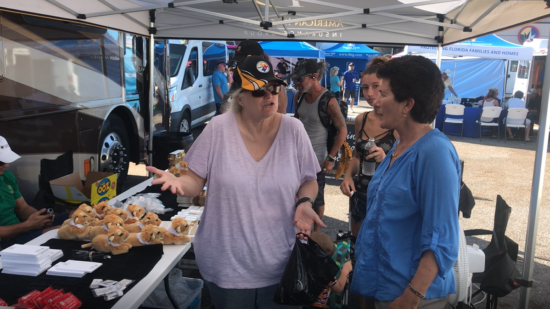
Lisa helps a policyholder at the Panama City insurance village
The devastation in Panama City and parts of the nine county region is worse than what I saw in Hurricane Andrew 26 years ago in Homestead, south of Miami. It is something you must see and then, hope you never see again. A common refrain I heard from residents and visitors alike was “I’ve never seen anything like this in my life.”
Pre- and post-storm, I was working with print, radio and television media to calm homeowners’ insurance fears and answer basic claims questions, including warning about Assignment of Benefits (AOB) contracts.
Last week, I was stationed for a few days at an insurance village in Panama City. These villages (there was another in Tallahassee) are designed to be a one-stop place for homeowners and automobile insurance policyholders to go to get questions about their coverage answered and to file expedited damage claims. The insurance company’s goal with these mobile emergency units is to help policyholders any way it can – plain and simple – and there was a lot of helping going on among the 44 carriers participating.
According to their website under “DFS Insurance Villages” the Department of Financial Services is hosting a third insurance village today and tomorrow (October 22 & 23) in Marianna in the parking lot of the Lowe’s from 8am to 4pm, CST.
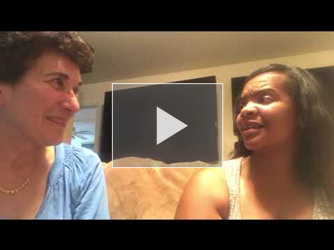 As an industry we know that the best thing we can do is stay close to our policyholders and give them the comfort they need and the assistance they need to help them put their lives back together.
As an industry we know that the best thing we can do is stay close to our policyholders and give them the comfort they need and the assistance they need to help them put their lives back together.
I traveled with two adjusters to evaluate a home not far from the insurance village. The woman who owned the home, Jasmine, worked for General Dynamics in a call center with 2500 others. The call center was destroyed in the hurricane, so she and all of her colleagues are out of work with no internet to seek alternative employment. Her house has water in it but her new two month old roof held, so she is more fortunate than others. There was story after story like this. You can click above to watch a two-minute conversation I had with Jasmine where she shares her experiences post-Michael.
Then there were those two adjusters, Jeromy Harding and Jason Brugh of Catalyst Insurance Management in New Port Richey. They came up to the panhandle early to help with search and rescue efforts bless their hearts and then to conduct cat adjusting for their clients.
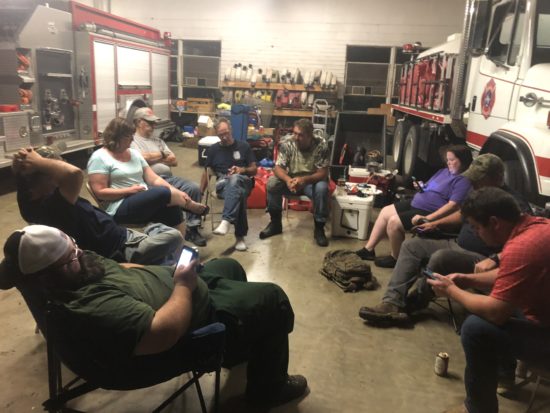
Members of the Greensboro Volunteer Fire Station
They helped the crew at the Greensboro Volunteer Fire Station in the rural town of Greensboro, just south of I-10, in the heart of the rural devastation. The picture at left was taken back at the station house after a hard day in the field that included putting out a house fire and using their Ford 250 pickup truck to re-right several travel trailers that had been rolled over during the storm (picture at right). Then it was on to Mexico Beach, ground zero for the hurricane’s landfall.
If you want to hear first-hand insights from two fine adjusters out in the field, click below to watch my two-minute conversation with Jeromy and Jason on what’s needed in building codes and mitigation techniques post-Michael.
Policyholders were still unable to report claims because of spotty cell and internet service. Based on my visual assessment of Bay County and surrounding areas, many, many more claims stand to be filed. One of the reasons AT&T seemed to have cell service back up faster than other carriers: they flew cell phone drones.
As for tarping, it appears FEMA won’t be able to have their tarp program fully operational for 2 weeks or so, so please let me know if you are having difficulty with tarp services. There are vendors who have capacity for this service.
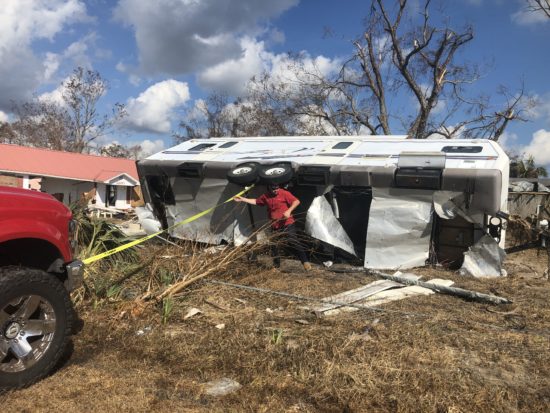
Jeromy Harding attaches a strap to a travel trailer overturned by Hurricane Michael’s Cat 4 winds
Automobile travel in Panama City was painfully slow. Some two and three mile stretches could take an hour due to the snarl of utility poles, lines, downed trees, and debris.
The State Emergency Response Team (SERT) has coordinated the establishment of 25 Points of Distribution (PODs) for food, water, and other critical supplied in counties hit hardest by Hurricane Michael. Major retailers really busted their humps to get back in operation, including Walmart, Publix, and Dollar General. That familiarity – that one little bit of normality – meant a lot in the early days of recovery.
There are more than 1,200 search and rescue personnel that have deployed to the impacted areas. They include nearly 300 ambulances with 600 staff.
Fish and Wildlife Conservation (FWC) officers will continue performing search and rescue, welfare checks, reconnaissance, public safety missions and assisting with debris removal. They are providing aid to areas of greatest need along the coast. FWC special teams continue working with the National Guard and Florida Fire Service USAR teams to create highly specialized urban search and rescue units. They are joined by special FHP units.
FEMA has approved more than $20 million so far in Individual Assistance now authorized in 12 counties. Another sign of progress: U.S. 98, the main road along the coast, has reopened.
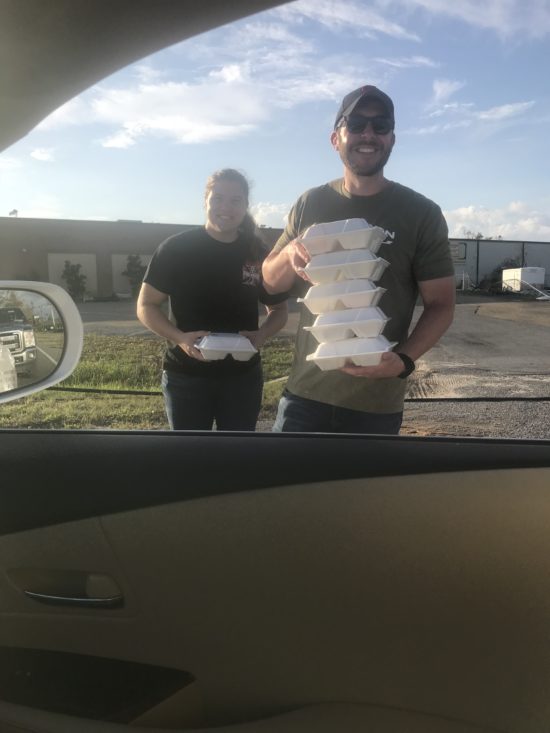
Volunteers Delivering Meals in Panama City after Hurricane Michael
Many schools in impacted areas, as well as Chipola College, Gulf Coast State College, and the FSU Panama City Campus have been without power. Public schools in the greater 9-county region are re-opening this week, with the notable exception of ground zero Bay County, which is striving to reopen no later than the week of November 12 – four full weeks post-Michael.
Living in the aftermath of a disaster consists of three essential necessities: temporary housing, tarping roofs, and storing household contents (furniture, sentimental items and other valuables). In insurance company speak, PODs are portable storage containers used by customers to put their contents in while a house is being repaired. It is anticipated that POD demand will grow. If anyone has a POD connection, please let me know because the local vendors are at capacity.
Looking ahead to this week, Disaster Resource Centers (DRCs) should be set up within the next few days in locations in each county. If you have policyholders who want to get to FEMA in addition to their insurance claims, the DRC is the place to do it. I have contacts with the affected counties so if you have an urgent need, please let me know.
Folks I talked with talk about and tell each other to stand together and help each other out. I witnessed neighbor helping neighbor, doing things like giving a ride or delivering a welcoming hot meal. There was some looting for sure, but in greater numbers were people coming together. In the face of such adversity, Panama City residents are testament that “giving is greater than receiving.”
AOB Fraud and Scammers
Hurricane Michael bringing out the best – and worst
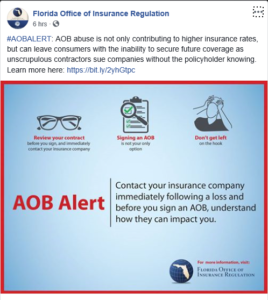
A Tweet from the Florida Office of Insurance Regulation
One of the things the insurance industry is doing to help make policyholders whole again after Hurricane Michael is to help fight scam artists and Assignment of Benefits (AOB) fraud. The bad actors are out in force. During my time in one Panama City neighborhood, one house had four flyers on the door and under the windshield of the homeowner’s car. You better believe that I called these vendors. One was a roofing company that uses an AOB and I am working to have them stop using one.
The other major problem is price gouging. Tree removal contractors are at the top of the list for price gouging. If you have preferred contracts with tree removal vendors, please notify your First Notice of Loss operators to stress to not use the ones that are on signs sitting in highway rights-of-way.
The Florida Department of Financial Services (DFS) a few days after the storm was warning consumers about these scammers and crooks. The warning signs: asking for cash up front and pressuring homeowners to sign an AOB before work can commence. Here’s the DFS release with Tips to Spot and Stop Post-Storm Fraud that you can share with your clients. The Office of Insurance Regulation is raising its game, sending the AOB Alert graphic at left via Tweet last week.
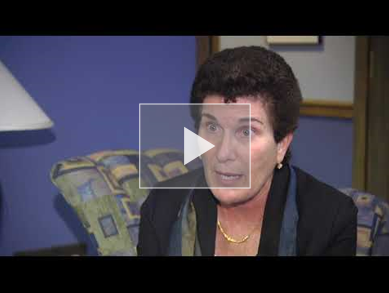 Two days after Hurricane Michael, I sat down with Mike Vasilinda, the capitol bureau chief for most of the NBC television stations in Florida to deliver the message loud and clear: “If you see a sentence that says, ‘I hereby assign all my rights of this policy to this vendor,’ do not sign it.” You can click to watch the interview at right.
Two days after Hurricane Michael, I sat down with Mike Vasilinda, the capitol bureau chief for most of the NBC television stations in Florida to deliver the message loud and clear: “If you see a sentence that says, ‘I hereby assign all my rights of this policy to this vendor,’ do not sign it.” You can click to watch the interview at right.
(Within a few hours of the television interview, I received this letter that provides proper “credentials” that can be used as our adjusters enter the field. I didn’t intend for the interview to have the spin that it did, but no matter – we got the issue resolved. The Department of Emergency Management’s Chief of Staff is an amazing leader and I am grateful that he responded so quickly.)
During two interviews with WFSU-FM, National Public Radio for Florida, one prior to and the other right after the hurricane, I stressed that an AOB contract is a license to steal, noting that the number of Florida lawsuits involving AOB has grown from 405 back in 2006 to 28,200 by 2016.
“We never had AOB in the claims paying process and all of a sudden it’s become the Holy Grail in getting a claim paid?” I challenged, citing Florida’s one-way attorney fees law that has encouraged abuse in the tremendous increase in AOB lawsuits over the years, without major weather events. You can listen to the full 8 minute interview here, which included consumer strategies for dealing with repair vendors.
The Florida Chamber-led Consumer Protection Coalition followed the next week with its ongoing campaign against AOB abuse. A News Service of Florida article (Hurricane Adds Fuel to Fight Over ‘AOB’) covered the issue from the different sides and stakeholders involved. The Restoration Association of Florida issued a news release last week, providing this pushback in the article: “We are extremely concerned about multiple advisories warning homeowners not to sign any contracts containing assignment of benefits language.” You can read their full statement at the above link.
We urge our newsletter readers to contact their local media and spread the word about “don’t sign what you don’t read.” AOB abuse and fraud is a statewide problem. Your policyholders, vendors, and colleagues will thank you for it!
Revising Florida’s State Constitution
Amendment 4 automatically restores felons voting rights
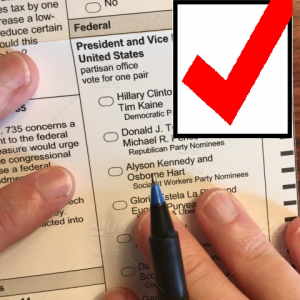 (Editor’s note: This is part of an ongoing series on the now 12 proposed state constitutional amendments that will appear on this November’s ballot for Florida voters to consider.)
(Editor’s note: This is part of an ongoing series on the now 12 proposed state constitutional amendments that will appear on this November’s ballot for Florida voters to consider.)
Amendment 4 is one of only two amendments on next month’s November 6 ballot that was created by a citizens’ initiative, where signatures had to be collected to place it on the ballot. This proposal would automatically restore the voting rights of felons after they serve all conditions of their sentences. Murderers and sex offenders, however, would continue to go before the Governor and Cabinet for restoration of their voting rights.
Currently, Florida is one of four states where convicted felons do not regain the right to vote, unless they go before a state board for consideration. Florida’s Executive Clemency Board, comprised of the Governor and Cabinet, used to routinely restore those rights for felons who had completed their sentences, paid restitution and other court requirements, and had no pending criminal charges.
When Governor Scott took office, he and the Cabinet changed that practice, requiring instead that felons wait five or seven years after completing their sentences, depending on the crime, before they could request consideration by the Board. Several groups filed a lawsuit and earlier this year, a U.S. District Court ruled that Florida’s current process was arbitrary and unconstitutional. Governor Scott’s administration appealed the ruling to the Eleventh U.S. Circuit Court, which concurred with the Governor and stayed the lower court’s ruling.
This amendment would restore the voting rights of Floridians with felony convictions after they complete all terms of their sentence including parole or probation. The amendment would not apply to those convicted of murder or sexual offenses, who would continue to be permanently barred from voting unless the Governor and Cabinet vote to restore their voting rights on a case by case basis.
Meanwhile, the Florida Supreme Court this past week decided the fate of three other proposed constitutional amendments on the ballot. The Court reviewed a claim that the three amendments were “unconstitutionally bundled,” with multiple measures in each amendment. The Court overturned a circuit court ruling and said Amendments 7,9,11 can stay on the ballot, noting bundling is not prohibited when amendments are placed by the Constitutional Revision Commission (CRC).
Amendment 7 changes University and State College systems’ governance, while providing scholarships to survivors of first responders and military members; Amendment 9 prohibits both offshore drilling and vaping in indoor workplaces; and Amendment 11 makes changes to property rights, obsolete sections of the Constitution, and criminal statutes. While the Court ruled that bundling is not prohibited when amendments are placed by the CRC, it should be noted that citizens’ initiatives, such as Amendments 4 & 3, are subject to a single-subject requirement.
For those looking for a deeper dive, with expert fiscal analysis and economic impact of the 12 proposed amendments on the November ballot, we’re happy to share this link to the Florida TaxWatch 2018 Voter Guide.
All proposed amendments to Florida’s constitution require a 60% majority vote to be approved. As many of our readers are Floridians, it’s important to know how each of these measures can affect us and our families, businesses, and employees. Knowledge is power! Election Day is Tuesday, November 6.
Helping Hurricane Michael’s Storm Victims
Finally, a word on how you can help with Hurricane Michael recovery. Volunteer Florida and the Red Cross are the two key agencies managing the monetary donations and household items. Volunteer Florida has activated the Florida Disaster Fund, the State of Florida’s official private fund established to assist Florida’s communities as they respond to and recover during times of emergency or disaster. To donate, visit, www.FloridaDisasterFund.org or text “DISASTER” to 20222 to make a one-time donation of $10. The American Red Cross has set up a link atop their website at www.redcross.org.
Volunteer Florida is continuing to work with more than 8,900 registered volunteers to connect them with volunteer opportunities. Among their duties, helping install thousands of FEMA tarps on damaged homes and handling some of the more than 5,378 requests so far for individual cleanup help.
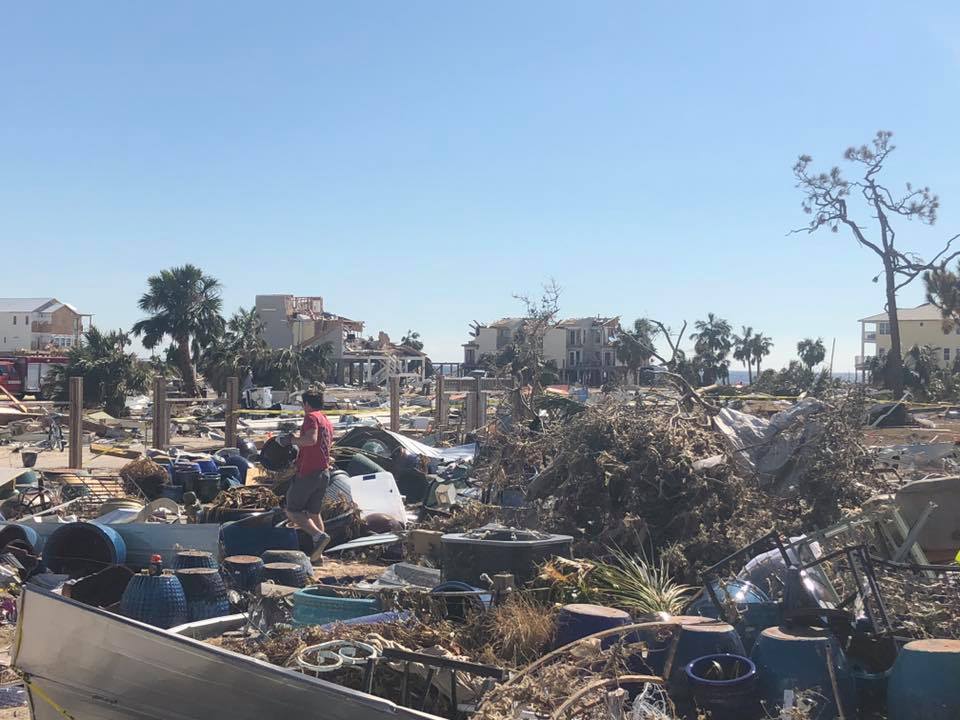
Mexico Beach, FL destruction from Hurricane Michael
The masters of mobile cooking, The Salvation Army, is working closely with state and local emergency management throughout the Florida Panhandle. Meal numbers have increased as residents are returning to the area to begin cleanup of their homes. They have established Incident Commands in Panama City, Apalachicola, and Tallahassee. The Salvation Army has committed 27 mobile feeding units to the Panama City Incident Command (serving Bay, Holmes, and Washington Counties), 9 mobile feeding units to the Apalachicola Incident Command (serving Franklin, Gulf, and Liberty Counties), and 11 mobile feeding units to the Tallahassee Incident Command (serving Calhoun, Gadsden, Jackson, Leon, and Wakulla Counties). Each unit can serve 500-1,500 meals per day. As of this past Saturday, The Salvation Army has provided 243,680 meals.
Our friends at the Florida Realtors® have put together a handy comprehensive reference guide to pass along to your clients who may have suffered losses and need a variety of help, including small business assistance.
Chief Judge Elijah Smiley of the five-county 14th Judicial Circuit has been working hard with staff to get limited clerk’s services going this new week. His comments in the local newspaper really capture the spirit of the Florida panhandle and its people: “There are many challenges. Our faith is enduring, and our spirits are too large to be crushed by any storm.”
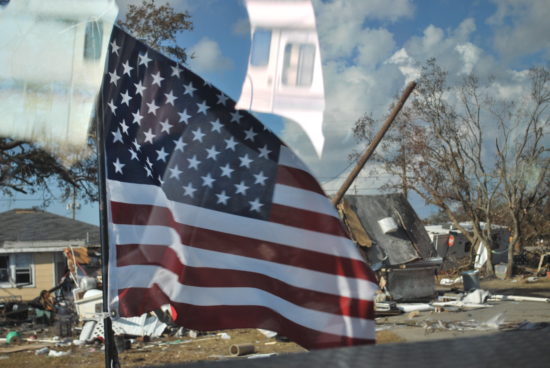
An American flag seen through the window of a pickup truck in a Bay County neighborhood
Please let me know how I can help each of you contribute, manage, observe, outreach, and succeed. During times of catastrophe, I do an informal daily email to several hundred people in the insurance business, with updates on critical developments and needs. If you’d like to be added to that email, we’d be happy to do so.
State officials said 285 people in Mexico Beach had refused to leave ahead of Hurricane Michael despite a mandatory evacuation order. Some have been found – others not, at least officially, as names of some of the dead remain unknown. Others remain in grave peril, including 98 year-old Theda England of Panama City, who simply refuses to leave her home as recently as this past weekend, even though her roof has partially collapsed and the structure is compromised. Our thoughts and prayers are with these folks and their families in this new week.


